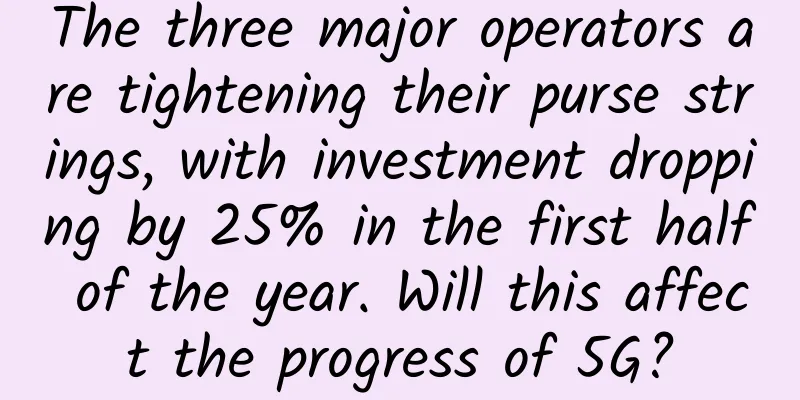The three major operators are tightening their purse strings, with investment dropping by 25% in the first half of the year. Will this affect the progress of 5G?

|
Recently, the three major telecom operators have released their first half financial reports. What has attracted much attention is that the three companies have tightened their wallets and invested cautiously. According to the financial reports, the three companies have invested a total of 127.3 billion yuan overseas, a year-on-year decrease of 25%. Among them, China Mobile has completed 46.8% of its annual planned investment, China Telecom has completed 31%, and China Unicom has only completed 20.4%.
5G construction is an important part of operators' investment. For example, 5G accounted for 58% of China Mobile's investment in the first half of the year, 41% of China Telecom, and China Unicom did not list it separately. "Previously, operators identified this period as the peak period for building new high-speed networks." Some media questioned whether such cautious investment would affect the speed of 5G construction? However, some industry insiders believe that the above speculation is a "false alarm." Yang Guang, senior analyst of wireless operator strategy at Strategy Analytics, told AI Finance that in fact, operators' investment throughout the year will not be less, it is a matter of investment rhythm. The 700MHz equipment bidding of China Mobile and China Broadcasting Corporation has just ended, and China Unicom and China Telecom are similar. "We missed the first half of the year perfectly, and it is not reflected in the financial report." On a larger scale, last year, there was a discussion in the industry that China’s 5G construction was ahead of schedule, with hundreds of billions of yuan invested, and it was likely that the investment would not be recovered. But then the Ministry of Industry and Information Technology said that it would adhere to “moderately advanced construction”. In July this year, the “Sailing Plan” led by the Ministry of Industry and Information Technology made it clear that 5G investment will maintain a high speed in the next three years. 5G base stations will reach 1.4 million by the end of the yearAI Finance learned from industry insiders that from the perspective of the full-year plan, the construction of 5G base stations has not slowed down, and is expected to reach 1.4 million by the end of the year. This is double the 718,000 at the end of 2020. The three major operators were cautious in their investments in the first half of the year, each with its own reasons. According to China Mobile, the reason for slowing down 5G construction in the first half of the year was that the issue of co-building the 700MHz frequency band with China Radio and Television was still under negotiation. Previously, China Mobile independently built its 5G network, but the 700MHz frequency band owned by China Radio and Television was of higher quality. In this frequency band, China Mobile and China Radio and Television will jointly build a 5G network. However, the organizational structure adjustment of China Radio and Television has delayed the progress of the two sides in building 5G. In 2019, China Radio and Television obtained the fourth basic telecommunications business license in China. After becoming the fourth telecommunications operator, China Radio and Television adjusted its organizational structure. "Previously, the radio and television networks were scattered across provinces. Now they need to be integrated into a national company. It will take some time before we can start bidding," said Yang Guang. On the other half of the market, China Unicom and China Telecom are jointly building 2.1GHz 5G base stations. They started bidding in July and plan to build 240,000 base stations. The results will be announced soon. China Telecom said that the slowdown in construction in the first half of the year was due to the shortage of semiconductors, which led to delays in purchasing equipment. On the other hand, "they also have to look at the situation of China Mobile to determine their own construction pace." Yang Guang said. Simply put, China Mobile and Radio and Television are building 5G networks in the 700MHz and 2.6GHz frequency bands, while China Telecom and China Unicom are building 5G networks in the 2.1GHz and 3.5GHz frequency bands. The recent bidding is for new frequency bands, while the 2.6GHz and 3.5GHz bands that have been partially built are also being expanded. "The expansion is still in progress, and the investment is huge, but it is not so eye-catching," said a communications person. In this regard, independent telecom analyst Fu Liang also said: The three major operators were in a "gear shift" period in the first half of the year. Before the new plan is fully implemented, it is normal to moderately slow down investment. In the second half of the year, 5G network investment will accelerate again. In July this year, the Ministry of Industry and Information Technology took the lead in releasing the "5G Application "Sailing" Action Plan", planning that by 2023, 5G access traffic will exceed 50%, the penetration rate will exceed 40%, the number of users will exceed 560 million, and there will be more than 18 5G base stations per 10,000 people. Even if calculated based on a population of 1.4 billion, 2.52 million 5G base stations will need to be built. From 2021 to 2023, a relatively large investment will be maintained. 5G cannot be calculated only in economic termsThe 5G part of the financial reports of the three major operators also has hidden concerns. The biggest problem is that the number of mobile business users is not growing. Even if 5G is doing well, there are only so many users. If the number of users does not increase, the ARPU (average monthly revenue per user) can only increase. After switching from 4G to 5G, the APRU of China Mobile users increased by 10%, which is already a very large increase, and there may be limited room for further improvement. Therefore, operators are currently turning their attention to the incremental market, namely government business. A person from ZTE told AI Finance that starting from 2019, the three major operators have put aside their airs and low-key sought cooperation with factories, which is different from the 4G era. "The factory has become the 'Party A' and the operator has become the 'Party B'." "The competition is fierce," said an industry insider. "As far as I know, a large enterprise is about to sign a memorandum of cooperation with China Unicom, while China Mobile is still poaching employees and looking for senior executives." Behind the fierce competition is a huge pie. According to China Mobile's 2021 first-half financial report, government business revenue was 73.074 billion yuan, accounting for 18.58% of total revenue, and has been increasing year by year in the past three years. Government business mainly involves 5G, cloud computing, and big data, and the growth rate of many parts is over 50%. For example, the growth rate of mobile cloud reached 118%. In contrast, the growth rate of the personal market is only 0.7%. In government and enterprise business, the impact of 5G cannot be measured only by numbers. "It has become a banner to build consensus and attract enterprises to speed up their digital transformation," said Yang Guang. In the past few years, the high exposure of 5G has attracted enterprises to increase their investment in infrastructure. From ports, mines to steel mills, there are cases of using 5G communications to command machinery and replace labor, which in turn affects the entire production process of enterprises. In this regard, operators have a lot of room for imagination. Unlike developed markets in Europe and the United States, the proportion of domestic enterprises using public cloud services is still not high. Operators have the opportunity to use 5G as a breakthrough to win this market. For example, they can build 5G private networks for enterprises and take advantage of the edge computing, cloud computing and various operation and maintenance needs of enterprises. Recently, China Telecom went public to raise funds, and the money raised was mainly invested in cloud computing; China Mobile also invested in cloud computing, big data, etc. Even so, compared with the total investment of hundreds of billions of yuan in 5G, it is not easy for operators to recover their investment in the short term. "But now is not the time to do economic calculations," said a communications person. Yang Guang also said that the four major operators are state-owned enterprises, and their decisions may be affected by more macro-economic development goals. Compared with 3G and 4G, 5G is the first time that China has taken the lead in communication networks, and is expected to drive the development of other industries. "It is nothing more than a question of whether to build roads first and then build cars (applications), or to build roads after traffic jams," said a communications person. |
<<: Mobile device management in the new era of 5G LAN
>>: Spectrum analysis of the four major 5G operators in China, who has the best resources?
Recommend
Gigabit broadband, who will buy it?
From the second half of last year to this year, t...
From UML to SysML: The language journey of describing complex systems
In the vast world of systems engineering, which l...
Linode's 18th Anniversary and Future Outlook
In the past two days, Linode released a blog post...
Wi-Fi 6 Column | Is Wi-Fi 6 omnipotent?
Wireless networks have been around for a long tim...
No-nonsense version: What are the common high-risk ports? Why should you close them?
Common high-risk ports (1) TCP port 21: The defau...
RepriseHosting: $35/month-2*E5-2650L, 32G, 1TB HDD/240G SSD, 10TB/1Gbps, Seattle data center
RepriseHosting is a foreign hosting company found...
WiFi optimization has tricks to surf the Internet without fighting
During the Dragon Boat Festival holiday, it is ne...
Reshaping Wi-Fi Infrastructure for the Future of IoT
As the digital age continues to evolve, a major c...
Huawei Cloud Internet Summit: 5G+Cloud will reshape the pan-Internet
Recently, the "Shanghai·Choose Extraordinary ...
Cloudie: Hong Kong/South Africa dedicated server monthly payment starting from US$50, 100M bandwidth unlimited traffic
Cloudie is a Hong Kong IDC Internet service techn...
Get WiFi signal first before enjoying the three-day New Year holiday
The New Year is coming, say goodbye to 2018, and ...
Hostaris: £18/year-2*AMD Epyc 7401P/2GB/50G NVMe/4TB/Germany data center
Hostaris is a foreign merchant with a relatively ...
Talk: How to explain 3PC to your girlfriend?
After a pleasant hotpot meal, I went home leisure...
Flink 1.14 New Features Preview
This article is compiled by community volunteer C...
edgeNAT newly launched US CUVIP 100M unlimited traffic VPS, 30% off for monthly payment and 40% off for annual payment
edgeNAT launched a new US CUVIP line VPS this mon...









